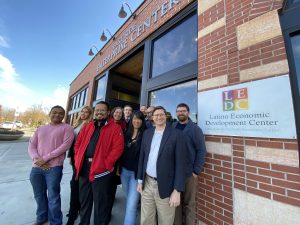Coordinating plans to visit a crime scene while buying flight tickets for Capstone Week. Speaking with classmates and clients over a Zoom call. Analyzing documents on your laptop after working a shift at your full-time job on the East Coast.
Gaining real-world experience in clinics as a law student at Mitchell Hamline can look a lot of different ways, and making those opportunities more available to students in the blended-learning program—who study remotely most weeks of the semester but also have required on-campus time—has been a priority of the school the past few years. The portion of clinic seats available to blended-learning students has been increasing in recent years and now is about half. Eleven of Mitchell Hamline’s 17 clinics are now open to blended-learning students, and two clinics have been designed specifically with blended-learning students in mind.
“Clinics have been our bread and butter for the past 51 years,” said Associate Professor Natalie Netzel ’15, director of the clinical program. Mitchell Hamline boasts one of the nation’s first clinical programs, which started in 1973 and is consistently highly ranked nationally. “It’s important to know we have created this opportunity for our blended students too. They have the same kinds of opportunities available to them to do legal work, supervised by law school faculty, that should fit and work with most schedules.”
In the fall of 2022, two clinics were introduced that were not simply open to blended-learning students but designed especially for them: the Wrongful Conviction and Sentencing Clinic and the Economic Inclusion Clinic.
Wrongful Conviction and Sentencing Clinic

Wrongful Conviction and Sentencing Clinic students test the plausibility of the prosecution’s case theory. Photo credit Lee Sexton.
The Wrongful Conviction and Sentencing Clinic, led by Professor Kate Kruse, collaborates with the Conviction Review Unit (CRU) of the Minnesota Attorney General’s Office, which opened in 2021.
The clinic works closely with the CRU to select which cases are their priorities and would lend themselves well to student work. In the two-semester clinic, students comb through thousands of pages of documents to analyze and summarize their findings, learning about the criminal legal system and what kinds of evidence will lead to a wrongful conviction along the way. The work of the clinic is well-suited to be completed remotely on the students’ own schedules, while Capstone Weeks allow them to look at evidence in evidence lockers, walk crime scenes, interview applicants in prison, and more while in Minnesota. It’s the perfect mix for the blended-learning format.
“I think it’s a really great opportunity,” said Kruse. “Students are really getting hands-on experience working on a real legal case, it helps bring all the other learning you’re doing in law school to life, and it also gives you a real connection to something that’s meaningful and valuable. Without the students, the CRU wouldn’t be able to do the work that they’re doing.”
Just this year, the CRU made its first ever endorsement of full exoneration for a defendant in a case which involved hundreds of hours of student clinic work.
Economic Inclusion Clinic

Economic Inclusion Clinic students pose in front of the Latino Economic Development Center.
The work of the Economic Inclusion Clinic, led by Professor Kim Vu-Dinh, also lends itself well to an online format. Students are able to gain practical experience drafting opinion letters on legal issues, evaluating an organization’s method for giving out small loans, providing counsel, and more, depending on the client’s needs. Among others, the clinic has notably worked with two educational institutions in Kosovo and a for-profit social enterprise distiller who works exclusively with minority farmers in Vietnam. The students have also worked with the Latino Economic Development Center, a local resource that has been tapped by the U.S. Small Business Administration on multiple occasions to support and lend to businesses from historically disenfranchised communities.
“I like to think of new ways to keep students engaged,” said Vu-Dinh, “and I try to pick clients that are interesting for our students.” All clients of the Economic Inclusion Clinic are social enterprises that address a community-based value, so students can see how being a lawyer in a transactional setting also helps communities.
‘Not everything will work for every person, but something will work for everyone’
The Covid pandemic largely helped Mitchell Hamline figure out that clinics for blended-learning students could be done and done well, said Netzel, though the pandemic was not the first time a clinic specific to blended-learning was offered. In 2019, the Housing Justice Chatbot-Building Clinic was introduced by Professor Ann Juergens and Lisa Needham ’02, who recognized the value of utilizing technology to provide clients with legal information. When the pandemic hit, Netzel and professors Ana Pottratz Acosta, Jon Geffen ’97, Joanna Woolman, and Kruse quickly designed and led the Covid-19 Legal Response Clinic in summer 2020, which helped dozens of Minnesota clients with legal needs surrounding the pandemic, predominantly unemployment denials. Neither clinic is offered today, but the shift toward opening up opportunities for blended-learning students remained.
Mitchell Hamline offers a diverse range of practical opportunities to all students, whether they are enrolled on campus or in blended learning.
Some clinics, through the nature of their work, are only available for students located in the Twin Cities, such as if they need to be physically present at a community partner location or available for a court appearance within 72 hours.
“A consideration in any clinic we’re developing is how we can best provide opportunities for our students, how we can fill unmet needs in our community, and whether the kind of work we do lends itself to blended students,” said Netzel. “Not everything will work for every person, but something will work for everyone.”
